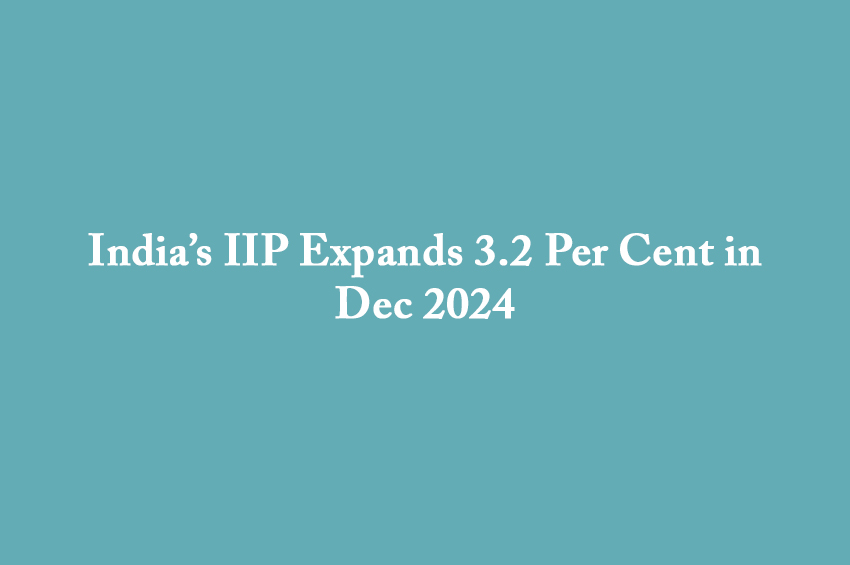Winning Bizness Economic Desk
The country’s Index of Industrial Production (IIP) registered a 3.2 per cent Year-on-Year growth in December 2024, according to data released by the Ministry of Statistics and Programme Implementation (MoSPI).
This number, it must be pointed out here, is a slowdown from the 5.2 per cent growth registered in November 2024.
Among key sectors, mining grew by 2.6 per cent, manufacturing by three per cent and electricity by 6.2 per cent in December.
Within the manufacturing sector, 16 out of 23 industry groups clocked a positive growth. Top contributors were the manufacture of basic metals (6.7 per cent), electrical equipment (40.1 per cent) and coke and refined petroleum products (3.9 per cent).
A significant growth was witnessed in products such as steel pipes and tubes, electric heaters and aviation turbine fuel.
By use-base of classification, capital goods registered a robust 10.3 per cent growth, while consumer durables expanded by 8.3 per cent.
However, consumer non-durables saw a contraction of 7.6 per cent indicating weaker demand.
Importantly, despite the slide from November, the industrial sector’s steady growth reflects resilience amid evolving economic conditions.
Retail Inflation Falls to 5-Month Low of 4.31 pc
India’s retail inflation slid to a five-month low of 4.31 per cent in January of this year from 5.22 per cent in December as food price inflation declined, government data showed.
The annual retail inflation in January was lower than economists’ estimate of 4.6 per cent.
In February, the Reserve Bank of India (RBI) trimmed its key policy rate for the first time in nearly five-years to boost an economy that is expected to grow at its slowest pace in four-years.
Here, it is important to point out that the government has just announced sweeping income-tax cuts in its February budget to perk-up consumption.
Vegetable prices increased 11.35 per cent Year-on-Year (YoY), as compared with a 26.6 per cent jump in December.
Prices of cereals rose 6.24 per cent as against a 6.50 per cent gain in December while that of pulses climbed 2.59 per cent as compared to a 3.80 per cent growth in the previous month.
What needs highlighting here is that winter harvests have helped moderate food prices but warmer-than-usual temperatures in March could pose risks to crops like wheat.
The Reserve Bank sees inflation averaging 4.8 per cent in the current financial year that ends in March 31 and expects it to ease to 4.2 per cent next year.
The central bank targets inflation at four per cent within a tolerance band of two percentage points on either side.
India’s Foreign Exchange Reserves Rise for Third Consecutive Week
India’ foreign exchange reserves climbed up USD 7.654-billion to USD 638.261-billion in the week ended February 7, according to the latest Reserve Bank of India data.
The point to highlight here is that this is the third consecutive week of a jump in the kitty which has increased by USD 1.05-billion to USD 630.607-billion for the week ended January 31.
Gold reserves increased by USD 1.315-billion to USD 72.208-billion during the week. Special Drawing Rights (SDRs) were down by USD 11-million to USD 17.878-billion, according to the data.
The reserves had been on a declining trend recently due to revaluation and with forex market interventions by the Reserve Bank to help reduce volatilities in the Rupee (the Indian currency).
The forex reserves had increased to an all-time high of USD 704.885-billion at end-September 2024.
For the week ended February 7, Foreign Currency Assets (FCAs), a major component of the reserves, increased by USD 6.422-billion to USD 544.106-billion, the data showed.
Expressed in dollar terms, the FCAs include the appreciation or depreciation of non-US units like the Euro, Pound and Yen held in the forex reserves.
India’s reserve position with the International Monetary Fund (IMF) was down by USD 71-million at USD 4.069-billion in the week under review, the RBI data showed.
India’s Palm Oil Imports Hit 14-Year Low
The country’s palm oil imports in January moved southward to their lowest in nearly 14-years as refiners turned to cheaper soyoil, driven by negative refining margins for palm oil, a leading trade body said.
Lower palm oil imports by India, the world’s biggest buyer of vegetable oils, are likely to weigh on benchmark Malaysian palm oil prices and support US soyoil futures.
Palm oil imports last month declined 45 per cent from December to 2,75,241-metric tonnes, the lowest since March 2011, the Solvent Extractors’ Association of India (SEA) said.
The country imported an average of more than 7,50,000-tonnes of palm oil every month in the marketing year that ended in October 2024, according to the SEA.
Palm oil usually trades at a discount to soyoil and sunflower oil, but dipping stocks have lifted its prices above rival oils, whose supplies are abundant.
Imports of soyoil in January moved northward 5.6 per cent to 4,44,026-tonnes, the highest in seven months, and sunflower oil imports increased 8.9 per cent to 2,88,284-tonnes, the industry body said.
Lower shipments of palm oil reduced the country’s total vegetable oil imports in January by 4.8 per cent to one-million tonnes, the lowest in eleven-months, it said.
A drop in vegetable oil imports over recent months lowered vegetable oil inventories to 2.18-million tonnes at the beginning of February, the lowest since April 2022, the SEA said.
Inda buys palm oil mainly from Indonesia, Malaysia and Thailand and import soyoil and sunflower oil from Argentina, Brazil, Russia and Ukraine.
India Ranks Ninth Globally Among Top Advertising Markets: Report
India’s advertising industry is projected to grow by seven per cent Year-on-Year (YoY) or an increase of Rs 10,370-crore to Rs 1,64,137-crore in 2025, according to a report by GroupM, the media investment group under WPP.
Globally, India ranks ninth among the top advertising markets, with the United States (US), China, the United Kingdom (UK), Japan and Germany leading the list.
“As global ad-spend surpassed USD 1-trillion, India emerges as a top four growth market, with digital now accounting for over sixty per cent of ad spend,” said Mr Prasanth Kumar, CEO, GroupM, South Asia, said in a statement.
However, in 2024, India’s advertising spending was impacted by lower election-related ad-spending during the Lok Sabha elections 2024 and marginal growth despite a major event like the 2024 Men’s T-20 World Cup,” said Praveen Sheik, Head of Business Intelligence, GroupM India.
This, along with an increase in raw material costs for consumer packaged goods and a less-than-expected festive boost further impacted overall ad-spending.
The digital medium is expected to generate an advertising revenue of Rs 99,137-crore in 2025. Sheik added that this will be driven by artificial intelligence, commerce, retail, media and hyper-personalisation marketing.
“India’s advertising eco-system is being reshaped by digital dominance and shifting consumer behaviours,” Mr Ashwin Padmanabhan, Chief Operating Officer, GroupM, said in a statement.
Rising investments from electric vehicles, fintech and gaming sectors were fuelling the digital advertising market’s momentum, he added.
Globally, the digital medium is expected to hold a market share of 82 per cent in 2025. The global advertising industry is expected to grow by 7.7 per cent to reach USD 1,116-billion.


